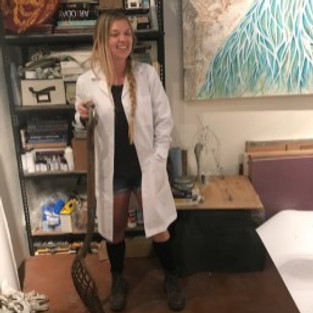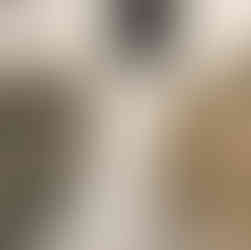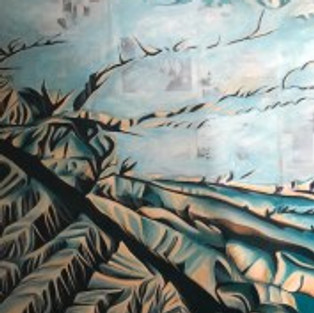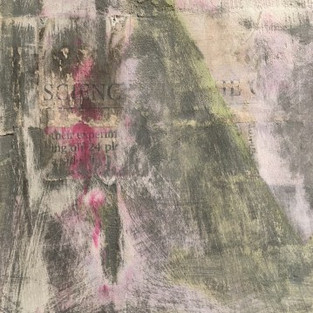
Britney Penouilh, Masks of Eternity & Mourning Drift polymer gypsum, etched Plexiglas, thread, 2017. Photo courtesy of the artist.
Artist Profile: Britney Penouilh, A Journey from New Orleans to LA
By Genie Davis
Artist Britney Penouilh was born in New Orleans and has done artists residencies in New York, Alaska, and North Carolina. Having moved to Los Angeles, she spends a great deal of time exploring the desert and its rich minerals and stones, often underground. If you’re sensing any dichotomies here, just wait: Penouilh studied both Fine Art and Geology at the University of New Orleans.
“Unlike Per Kirkeby, who was a geologist before creating an important career as a visual artist, I began as an artist, wandered to geology and found myself back where I started with new insights,” Penouilh explains. “I tested my relationship with science by taking on dual academic studies. I also worked in a Geology Lab analyzing core samples from Indonesia. After exploring the earth, the laboratory and the underground, my relationship with geology was realized. It would become my muse for many years.”
But now she’s fused her two passions. The work she creates is both fascinating and enigmatic, as jeweled and multi-faceted as any mineral she studies. “Initially, I was studying scanning electron microscopic images when I decided to render scientifically inspired works. There were these amazing microscopic worlds unseen by people who weren’t studying rocks. I wanted to share that.” She says at the time, her work was much more literal. “Over time, I’ve shifted from geometries and micro-universes to the macro-landscapes of the Earth. The Earth is a living organism and any shift in the landscape profoundly alters our reality.”
She’s deeply drawn to the California desert by her twin pursuits, and describes in visceral terms the artistic and exploratory rush she gets from visiting there. In some ways, Penouilh is like the Indiana Jones of artists.
“Picture yourself descending 400 feet beneath the surface of the Earth. You are wearing a headlamp, oxygen is low, but the walls are embedded with 32 million years of history. Minerals and crystals forming through heat and pressure in pockets of mud, and this mud contains the DNA of the Earth 32 million years ago,” she relates. “This mud is a record of air quality, water quality, crops, and everything that has drained through the soil, and has been absorbed. I take this journey.”
The artist says she travels underground to study the land because she believes strongly that to understand the present, you must understand the past. “My mixed media paintings incorporate records of history, literature, sheet music, and scientific texts collaged beneath a surface built up with plaster, graphite, and acrylic paint. The final surfaces of these paintings are weathered – like the land – and subliminally reveal text relevant to the subject matter.”
She utilizes a variety of formats: pen, ink, pencil drawings, paper and plaster, casting, and minerals and people themselves in her work.
“I learned to live cast during my time in New York, working with hyperrealist sculptor Carole Feuerman. My work never fully assembles a form into a figure. Body parts are casted, fractured, and fragmented and used for wall sculptures and altars,” Penouilh says.
Recently, she began combining elements. Sculpting on panels, casting minerals, and etching into plaster, she finds that her materials are switching places and colors are being further explored.
Asked if she sees herself as a conduit to revealing nature’s beauty to the art world, she demurs – although in literal terms, she is doing just that. “I see my work as a materials study of the tensile strength and weakness of both the land and the materials I am working with.”
As an example, one can look at her piece In The Trembling of Earth | Glacial Silt, where fragments of text are arranged like stones bound together, a binding result of glacial melt and the force of silt deposits.
“Coming from New Orleans, where there is no bedrock and the land was simply thousands of years of sediment deposits in the Mississippi Delta, but losing land at the same rate of creation along the ring of fire, I experienced a deep shift in perspective during an artist residency in Lake Clark, Alaska,” she explains.
Other works reflect other places. “My piece Life Lines & Dead Zones was a commission for a riverboat pilot in New Orleans. Above vintage maps, literature, antique etchings and plaster, is an image of the mouth of the Mississippi River, where she makes her final deposits before flowing into the Gulf of Mexico.”
Elastic Rebound is based on a theory for how energy is released during an earthquake, Penouilh attests. “As adjoining plates on the Earth’s surface move in opposite directions, the rocks, which span the opposite side of the incipient fault, are subject to extreme shear stress. Slowly they deform, until their internal rigidity is exceeded. Then they separate with a rupture along the fault line; the sudden movement releases accumulated energy, and the rocks snap back to their original shape.” You can almost feel this happening in her mixed media on panel.
As an artist, Penoulih represents the variety of landscapes she’s seen firsthand: Alaska’s arctic, Louisiana’s swamp, and California’s desert. “I am interested in the flow of energy within the earth and how it manifests on the surface on the land and ultimately affects our human experience, our reality,” she says.
The earth itself may be her artistic religion, but she’s also created altar work that would fit into a cathedral – at least a non-traditional one.
“In New Orleans, I built altars at International House for ritual celebrations throughout the year: Carnival, St. Joseph’s Day, St. John’s Eve (Summer Solstice), and All Saints/All Souls. Ritual is part of the cultural identity of New Orleans,” she notes. “The altars are, for me, emotionally, a penance and a meditation on generations of people who have celebrated the same rituals, and I am carrying their flame.”
She describes the design of altars as being 3-dimensional tableaus that “reinforce a narrative with items of both superstition and sacred meaning. Each item tells a story or has a meaning.” She embraced this art form and this tradition, and when she moved to California, and became obsessed with the San Andreas Fault, Penouilh decided that her research on its past, present and predicted future – and one particularly riveting story – would be most appropriately displayed on an altar rather than a painting. “Alice Eastwood was the curator of the botany department at the California Academy of Sciences. When a magnitude 7.8 earthquake shook San Francisco in 1906, Eastwood risked her own life to save these plants from the fires that consumed the city. Eastwood managed to save 1,497 rare specimens. She is the reason these plants still exist today. Alice Eastwood is the heroine of the Earthquake of 1906,” Penouilh says, and now Eastwood has an altar paying her homage.
Penouilh’s work is as much a product of dedication and passion as Eastwood’s was. Viewers will find the earth entwined in the artist’s work. From polymer gypsum sculptures of crystals she’s dug underground to her profoundly moving “Altar of Alice Eastwood,” from fragile and broken masks to delicately rendered views of land and fissures and mountains and stones, one can’t help but feel Penouilh’s work channels the raw beauty, symmetry, and mystery of the planet we call Earth within the many-faceted visual universe of her art.
#losangeles #california #losangelesartist #art #geniedavis #studiovisit #contemporaryart #Geologyandart #geology #southerncalifornia #abstract #minerals #artgallery #CaliforniaDesert #artistprofile #NewYork #artandcake #artopening #artexhibition #ArtandCakeLA #artists #artist #mixedmedia #BritneyPenouilh #environment #artreview #sculpture #artmagazine #NewOrleansartist #ArtandCulture #exhibition #artiststudio #exhibit #artprofile #drawing










































































